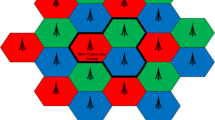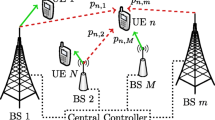Abstract
This paper focuses in the analysis of 100% static and distributed inter-cell interference coordination techniques in the context of LTE networks. Several methods have been modeled and studied with the aim of deriving practical radio planning rules based on the joint effect of operational parameters and thresholds. The investigation places special emphasis on the efficiency vs. fairness tradeoff through a set of metrics that allow not only to evaluate the measurements from different points of view, but also to look at the effectiveness in radio resources usage. Results show that similar levels of spectral efficiency can be achieved by means of a proper and accurate network tuning. Moreover, interesting second order differences appear due to inherent features of each approach. These can be exploited depending on the particular network operator needs.
Access this chapter
Tax calculation will be finalised at checkout
Purchases are for personal use only
Preview
Unable to display preview. Download preview PDF.
Similar content being viewed by others
References
3GPP: TR 25.814 v7.1.0 (Release 7) - Physical layer aspects for Evolved Universal Terrestrial Radio Access (UTRA). Technical Report, 3GPP (2006)
Alcatel-Lucent: R1-072568: Voice over IP resource allocation benefiting from Interference Coordination. 3GPP, TSG RAN WG1 Meeting #49: Kobe, Japan (May 2007)
Huawei, G.: 3GPP TSG RAN WG1 Meeting #41 - Soft Frequency Reuse Scheme for UTRAN LTE. Technical Report available as R1-050507, 3GPP (2005)
Ericsson, G.: 3GPP TSG RAN WG1 Meeting #45 - Downlink Inter-cell Interference Co-ordination/Avoidance - Evaluation of Frequency Reuse. Technical Report available as R1-061374, 3GPP (2006)
Alcatel, G.: 3GPP TSG RAN WG1 Meeting #44 - System Simulation Results for Downlink Interference Coordination. Technical Report available as R1-060209, 3GPP (2006)
Zhang, X., He, C., Jiang, L., Xu, J.: Inter-cell Interference Coordination Based on Softer Frequency Reuse in OFDMA Cellular Systems. In: Proc. IEEE Int. Conf. Neural Networks and Signal Processing (ICNNSP 2008), Zhenjiang (China), June 7-11 (2008)
Ruiz, S., Haro, E., González, D., García-Lozano, M., Olmos, J.: Comparison of Different Distributed Scheduling Strategies for Static/Dynamic LTE Scenarios. Technical Report available as TD(09)992, COST, Wien (Austria) (September 28-30, 2100)
Elayoubi, S.E., Haddada, B., Fourestié, B.: Performance Evaluation of Frequency Planning Schemes in OFDMA-based Networks. IEEE Trans. on Wireless Comm. 7(5), 1623–1633 (2008)
Corvino, V., Gesbert, D., Verdone, R.: A Novel Distributed Interference Mitigation Technique Using Power Planning. In: Proc. IEEE Wireless Comm. and Networking Conf (WCNC 2009), Budapest (Hungary), April 5-8 (2009)
Boghe, M., Gross, J., Wolisz, A.: Optimal Power Masking in Soft Frequency Reuse Based OFDMA Networks. In: Proc. European Wireless Conf (EW 2009), Aalborg (Denmark), May 17-20 (2009)
Boudreau, G., Panicker, J., Guo, N., Chang, R., Wang, N., Vrzic, S.: Interference coordination and cancellation for 4G networks. IEEE Communications Magazine 47(4), 74–81 (2009)
Alcatel: R1-050407: Interference Coordination in new OFDM DL air interface. 3GPP, TSG RAN WG1 Meeting #41: Athens, Greece (May 2005)
Nortel: R1-060905: Adaptive Fractional Frequency Reuse. 3GPP, TSG RAN WG1 Meeting #44bis: Athens, Greece (Mar 2006)
Samsung: R1-051341: Flexible Fractional Frequency Reuse Approach. 3GPP, TSG RAN WG1 Meeting #43: Seoul, Korea (November 2005)
Jain, R.: The Art of Computer Systems Performance Analysis, 1st edn. John Wiley & Sons, New Yotk (1991)
3GPP: TR 36.201 v8.2.0 (Release 8) - LTE Physical Layer - General Description. Technical Report, 3GPP (2008)
3GPP: TR 36.211 v8.5.0 (Release 8) - Physical Channels and Modulation. Technical Report, 3GPP (2008)
3GPP: TR 36.212 v8.5.1 (Release 8) - Multiplexing and Channel Coding. Technical Report, 3GPP (2008)
Brueninghaus, K., Astely, D., Salzer, T., Visuri, S., Alexiou, A., Karger, S., Seraji, G.A.: Link performance models for system level simulations of broadband radio access systems. In: IEEE 16th International Symposium on Personal, Indoor and Mobile Radio Communications, PIMRC 2005, vol. 4, pp. 2306–2311 (November 2005)
Fraile, R., Lázaro, O., Cardona, N.: Two Dimensional Shadowing Model. Technical Report available as TD(03)171, COST 273, Prague (Czech Rep.) (September 24-26, 2003)
Olmos, J., Serra, A., Ruiz, S., García-Lozano, M., González, D.: Exponential Effective SIR Metric for LTE Downlink. In: Proc. IEEE Int. Symp. on Personal, Indoor and Mobile Radio Comm. (PIMRC 2009), Tokyo (Japan), September 13-16 (2009)
Zheng, H., Wu, M., Choi, Y., Himayat, N., Zhang, J., Zhang, S.: Link Performance Abstraction for ML Receivers Based on RBIR Metrics. Technical Report C802.16m-08, IEEE (2008)
Author information
Authors and Affiliations
Editor information
Editors and Affiliations
Rights and permissions
Copyright information
© 2010 Springer-Verlag Berlin Heidelberg
About this paper
Cite this paper
González G., D., García-Lozano, M., Ruiz, S., Olmos, J. (2010). Static Inter-Cell Interference Coordination Techniques for LTE Networks: A Fair Performance Assessment. In: Vinel, A., Bellalta, B., Sacchi, C., Lyakhov, A., Telek, M., Oliver, M. (eds) Multiple Access Communications. MACOM 2010. Lecture Notes in Computer Science, vol 6235. Springer, Berlin, Heidelberg. https://doi.org/10.1007/978-3-642-15428-7_21
Download citation
DOI: https://doi.org/10.1007/978-3-642-15428-7_21
Publisher Name: Springer, Berlin, Heidelberg
Print ISBN: 978-3-642-15427-0
Online ISBN: 978-3-642-15428-7
eBook Packages: Computer ScienceComputer Science (R0)




